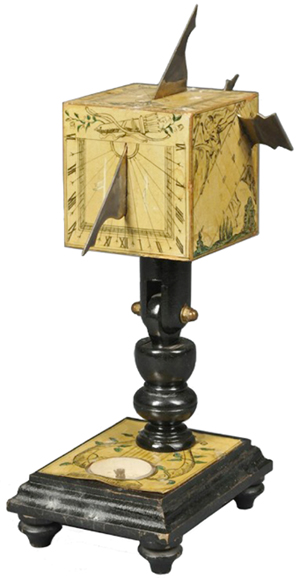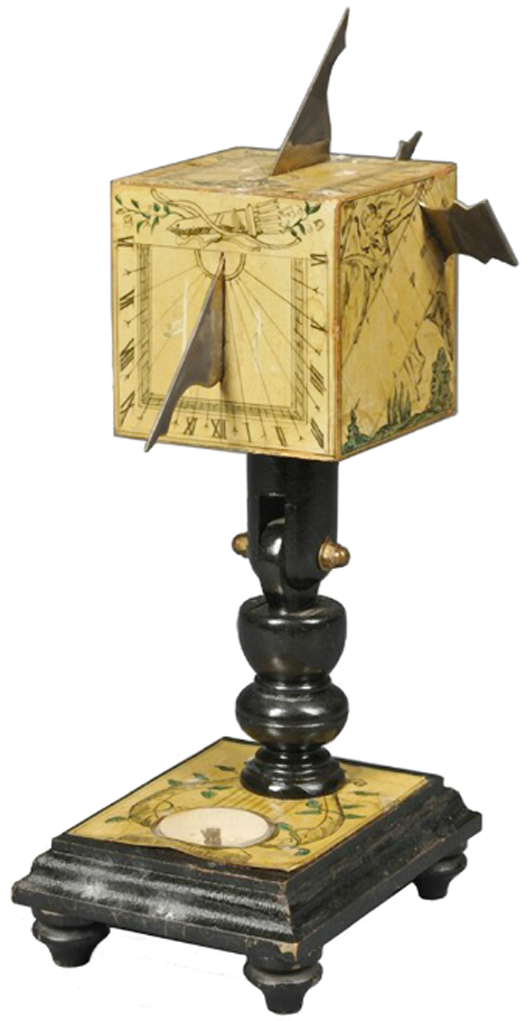
A stick’s shadow, sundials, clocks, watches and wristwatches have all made it easier for a person to tell time. The earliest known sundial dates from about 800 B.C. The first pendulum clock was made in the 1600s, and pocket watches were being used by the 1700s. By the 1800s, there were mechanical clocks, and the clock in a nearby church steeple was the best way to tell the exact time.
Trains were the favored form of transportation, and riders had to know when the train would arrive and depart, so accurate watches were necessary and regulated time zones were put in use. It is said that people could set their clocks when they heard the nearby train whistle’s sound.
By World War I, people were wearing wristwatches to tell time, and today many use a cellphone or computer. But all of history’s time-telling methods are still in use, even the sundial.
The common garden-variety sundial is an ornament that requires proper placement in the yard to tell the time. Of course, when daylight saving time is in effect,it is one hour off. One rare sundial is the Beringer style, which has five dials and five shadow casters (called “gnomons”). It is shaped like a cube on a stand. Each side and the top have a dial and a gnomon in the proper position. It was invented by David Beringer in Germany in the 1800s and is very accurate, but it is complicated to install. A wooden example sold in 2011 for $350. A few are in museums.
Q: I have a Podmore Walker “Temple” pattern “flow brown” platter, 13 1/2 x 10 1/4 inches. I inherited it from my parents’ Victorian china collection. As much as I’ve been able to determine, it is a Podmore, Walker & Co. original because it’s marked “P.W. & Co.” While such platters usually are flow blue, did Podmore Walker also make flow brown? Is it authentic, and what would its value be?
A: Podmore, Walker & Co. was in business in Tunstall, Staffordshire, England, from 1834 to 1859. Enoch Wedgwood joined the company in about 1849. When he became a partner in 1856, the name of the company was changed to Podmore, Walker & Wedgwood. The company became Wedgwood & Co. in about 1860. The color of your platter may be what collectors call “mulberry.” It looks like brown. Value: about $200.
Q: My husband was given a small wooden table in the 1960s. It’s 30 inches square with two shelves. The label on the bottom says, “A Leopold Stickley Original, L. & J.G. Stickley, Inc., Fayetteville, N.Y., Maker of Cherry Valley Furniture.”
A: Leopold (1869-1957) and John George (1871-1921) Stickley, two of the five Stickley brothers who entered the furniture business, established their furniture manufacturing company in Fayetteville in 1902. The firm, like the other Stickley companies, sold Arts and Crafts furniture. When interest in that style waned in the 1920s, L. & J.G. Stickley introduced a line of Colonial Revival furniture marketed as “Cherry Valley.” The line was produced until 1985, when the company was sold and moved to Manlius, N.Y., where it is still in business. The label on your table was used from 1945 to 1985, so your table is not an early one. But pieces in the Cherry Valley line are well made and sell for about what comparable new pieces would bring.
Q: I’m considering selling a silver tea service to someone who buys gold and silver items. I’m now wondering if the set may be worth more than meltdown value. The sugar and creamer are marked “925 Sterling” on the bottom. The set’s tray is worn and all I can make out in the first line of the mark on the bottom is “rlboro Pla.” Under that is, “by Morton Parker, Canada, E.P. Brass, lead mounts.”
A: Morton Parker is a Canadian company founded in Trenton, Ontario, in 1945. It is still in business and is still run by members of the Parker family. The company makes silver-plated and stainless-steel hollowware for the retail market and the food-service industry. The words that are partly worn off the bottom of your electroplated brass (“E.P. Brass”) tray indicate that it’s from the company’s “Marlboro Plate” line. Places that buy silver are looking for sterling silver, not silver-plate. The standard for sterling silver is .925 silver (out of 1.000 parts). Your silver-plated tray is not worth much, but the sterling-silver hollowware pieces are worth at least meltdown value. The price of silver fluctuates, but you can check the current market price by using one of the meltdown calculators on online sites.
Q: I have a clear glass bottle embossed “Syrup of Black Draught.” It has a stopper top. I found it in a garbage dump near an old farmhouse site in northern Kentucky. The interior of the bottle is very wavy compared to the outside. I suspect it might be 60 to 100 years old. Do you know anything about this bottle?
A: Dr. A.Q. Simmons invented a patent medicine in 1840 he called “Thedford’s Black Draught.” The main ingredient was senna, a plant used as a laxative. In 1879, Z.C. Patten bought the rights to Black Draught and dropped “Thedford’s” from the name. He founded the Chattanooga Medicine Co. to make and distribute it. Syrup of Black Draught is still being made and is now produced in syrup and tablet form by Lee Pharmaceuticals, a personal-care products company established in California in 1971. Black Draught signs, dispensers and ephemera can be found. Dolly Parton wrote the lyrics to the Black Draught theme song, which includes the line “Black Draught makes you smile from the inside out.”
Tip: To hide a scratch on wooden furniture, rub it with a matching shade of shoe polish. A child’s wax crayon also might work.
Need prices for collectibles? Find them at Kovels.com, our website for collectors. More than 84,000 prices and 5,000 color pictures have just been added. Now you can find more than 900,000 prices that can help you determine the value of your collectible. Access to the prices is free at Kovels.com/priceguide.
Terry Kovel answers as many questions as possible through the column. By sending a letter with a question, you give full permission for use in the column or any other Kovel forum. Names, addresses or email addresses will not be published. We cannot guarantee the return of any photograph, but if a stamped envelope is included, we will try. The volume of mail makes personal answers or appraisals impossible. Write to Kovels, Auction Central News, King Features Syndicate, 300 W. 57th St., New York, NY 10019.
CURRENT PRICES
Current prices are recorded from antiques shows, flea markets, sales and auctions throughout the United States. Prices vary in different locations because of local economic conditions.
- Rhinestone pin, 1930s candlestick phone, 24 baguettes set in silver-tone metal, 2 x 1 inches, $35.
- “The New Connecticut Cookbook,” Women’s Club of Westport, Conn., 1st edition, 1947, 338 pages, $50.
- Nippon cheese dish, cover, moriage decoration, raised gold design, circa 1910, 7 1/2 x 5 3/4 inches, $75.
- Kristy McNichol doll, blue jeans, red jacket, white T-shirt, Mego, 1978, sealed box, 9 inches, $90.
- Pajama bag, Yogi Bear, vinyl head, felt bowtie, cotton twill body, plush hands, zipper in front, Knickerbocker, Hanna Barbera copyright, 1961, 12 x 20 inches, $100.
- Toast tongs, sterling silver, handles in shape of pierced butterflies, circa 1900, 7 inches, $175.
- Royal Doulton figurine, Kate Hardcastle, red dress, HN 2028, 8 1/4 inches, $185
- TV tray set, Baltimore Colts, World Champions, white tin, blue logo with crown, gold metal legs, 1958-59, 15 3/4 x 20 3/4 inches, set of four, caddy, $225.
- Toy hot-dog vendor wagon, Pepsi-Cola logo on side, detachable man, umbrella lifts off, doors open, Ideal, 1945, 8 x 9 inches, $675.
- Table, mahogany, four turned legs with spiral twists, Merklen Brothers, circa 1885, 17 x 26 inches, $795.
Available now. The best book to own if you want to buy or sell or collect—and if you order now, you’ll receive a copy with the author’s autograph. The new “Kovels’ Antiques & Collectibles Price Guide, 2012,” 44th edition, is your most accurate source for current prices. This large-size paperback has more than 2,500 color photographs and 40,000 up-to-date prices for more than 775 categories of antiques and collectibles. You’ll also find hundreds of factory histories and marks, a report on the record prices of the year, plus helpful sidebars and tips about buying, selling, collecting and preserving your treasures. Available online at Kovelsonlinestore.com; by phone at 800-303-1996; at your bookstore; or send $27.95 plus $4.95 postage to Price Book, Box 22900, Beachwood, OH 44122.
© 2012 by Cowles Syndicate Inc.
ADDITIONAL IMAGE OF NOTE


